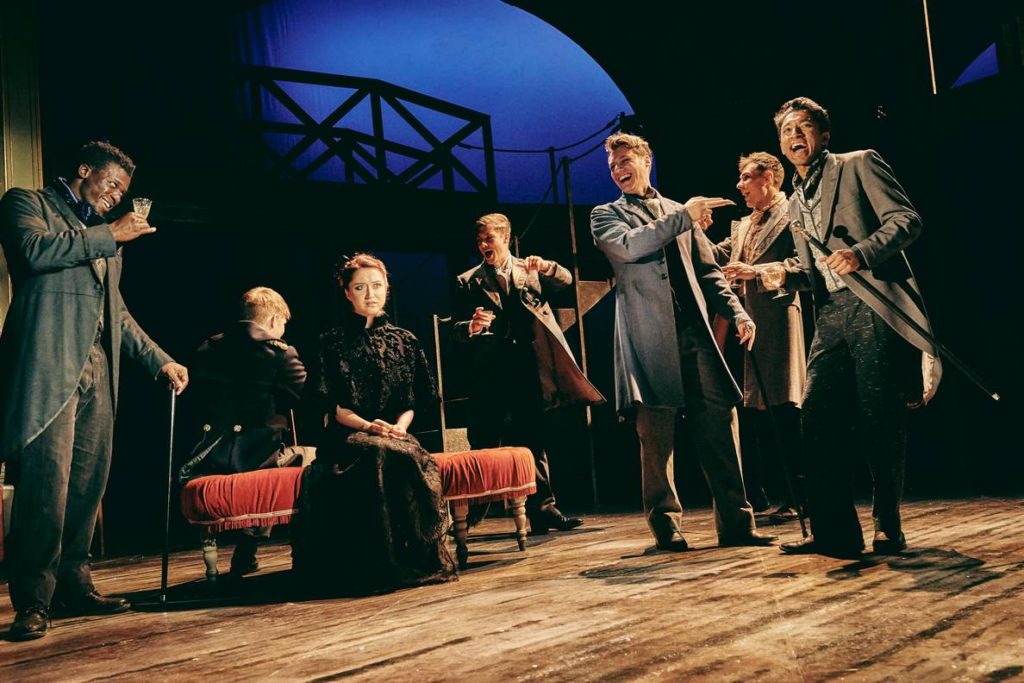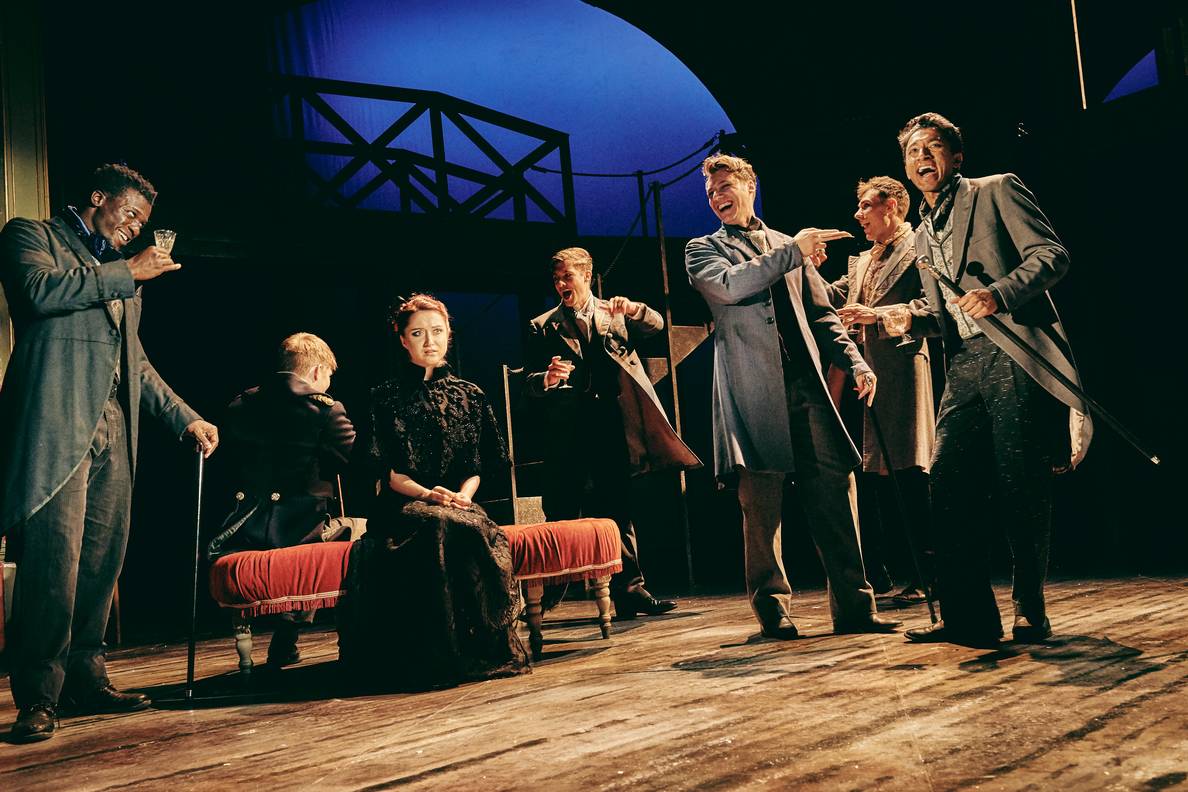
These shows vividly bring to life Dicken’s extraordinary world of cruel tyrants, wide-eyed innocents, comic grotesques and noble heroes. Each separate production is an impressive stand-alone achievement; taken together, they surely represent a new high-water mark for the Bristol Old Vic Theatre School. If I have had a little more to say about Part I than Part II, that is only because very many of the characters and locations that are encountered in the first show are met again in the second. If you can get to see both productions, do so, for you will be in for an epic theatrical treat.
Part I: From the off it is clear that this show has ensemble work at its heart. There are splendid individual performances, not least from Kel Matsena in the title role and Eva O’Hara as his sister Kate, but throughout there is the uplifting sense of a community of twenty-six young actors working together to create an authentic Dickensian experience. Narrative and dialogue are skilfully woven together as the complex plot evolves, and the stage is frequently filled with much hustle and bustle as the story takes us from the financial struggles of the Nickleby family in London to the cold privations of Wackford Squeers’ school, Dotheboys Hall, in Yorkshire.
Villainy is represented in various forms. Will Fletcher is a chillingly bloodless Ralph Nickleby, the epitome of the wicked uncle. His icily clenched, money-grabbing materialism contrasts with the physically intimidating Wackford Squeers. This gleefully sadistic schoolmaster is played with forceful energy by Louis J Rhone. Squeers’ equally unpleasant wife is played with flamboyant nastiness by Moronke Akinola. Anna-Kate Golding is wonderfully funny as their fantasising daughter, Fanny, who convinces herself that the new young assistant teacher has taken a shine to her.
That young teacher is Nicholas Nickleby himself, who is blissfully unaware of Fanny’s feelings. Another fantasist is Nicholas’s mother, forever imagining a golden future for herself and her children, Nicholas and Kate. Mrs Nickleby is an unstoppable chatterbox, whose naïve wishful thinking renders her an easy victim to her brother-in-law’s machinations. She is a silly woman, but in Lydia Gard’s well-judged performance her essential goodness outweighs her failings.
Kate Nickleby becomes employed by Mr Mantalini, a self-dramatizing milliner with a penchant for grand gestures. Tom Briggs is excellent as Mantalini, breezily assured of his own brilliance one moment, and unconvincingly threatening suicide the next. Beshlie Thorp’s Mrs Mantalini is driven to distraction by her husband’s foolishness, but quickly comes over all a-quiver whenever he offers her extravagant flattery. Down in their dress shop, Holly Carpenter is a fabulously fluttery Miss Knag, the forewoman who initially takes a liking to Kate, but who soon comes to resent her youth and beauty.
Amid this swirling pageant of colourful characters, Nicholas and Kate Nickleby represent common humanity. Kel Matsena is a very likeable Nicholas, eager to do what is right, but inexperienced in the ways of the world and inclined to impulsivity. Eva O’Hara gives Kate a touching dignity and moral strength. She has a clearer-eyed view of the world than either her brother or her mother. The cruellest injustices of that world are represented by Smike, the most helpless victim of Squeers’ thrashings who becomes Nicholas’s companion on the road. Oscar Porter is very moving as this poor, slow-witted lad, whose greatest academic achievement is to be able to spell ‘outcast’.
After many misadventures, Nicholas and Smike encounter the Crummles theatrical troupe, and become actors. The Crummles are an eccentric bunch, with their young daughter, The Infant Phenomenon, being the oddest of the lot. Rosie Taylor-Ritson plays her as an animated doll with an eerily fixed smile and an unnerving tendency to execute extravagant balletic spins and leaps at inappropriate moments. An exceptionally funny play-within-a-play sequence is created by the Crummles’ determinedly cheerful performance of the last act of Romeo And Juliet, with corpses springing to life left, right and centre. Tom Briggs, as Master Crummles, shows an impressive disregard for both the rhythms of iambic pentameter and the meanings of the words. Seldom can Shakespeare’s verse have been mangled to greater comic effect.
Part I ends on a rousingly optimistic, patriotic note, but there are grave injustices that are yet to be resolved.
Part II: Of necessity, the second part opens with a telling of the story so far, but this is delivered with admirable brevity, and the show quickly gets into its stride. Overall the tone is somewhat darker than in Part I. There are sad partings, grim retributions, and deaths. However, all is not gloom, for there are many light-hearted moments, too. Nicholas finds employment with the Cheeryble twins, Ned and Charles, who are played by Lawrence Haynes and Jonathan Oldfield with cleverly choreographed gestures and mannerisms that emphasise their interchangeable personalities. With their unfailing generosity and kindness, they represent the acceptable face of capitalism. In the original novel they are German, but here they have become charmingly Welsh.
Kate becomes the hired companion of Mrs Wititterly, a hypochondriac who cannot bear to be challenged in the slightest way. She is doted on by her husband, who sports an over-sized quiff and a wather fey way with pwonunciation. Initially, Mrs Wititterly enjoys Kate’s companionship, but she wilfully misinterprets her behaviour and she and her husband turf her out. Karla Kauky and Finnbar Hayman deftly show this couple’s shift from eccentricity to outright viciousness. Hayman does a nice line in grotesques, for he later becomes the odious Arthur Gride, co-conspirator with Ralph Nickleby.
Kate Nickleby’s good looks frequently lead her into trouble, though never through any fault of her own. Her beauty arouses envy and jealousy in others, causing her to lose jobs, and her attractiveness brings her to the misogynistic attention of a group of hard-drinking, predatory aristocrats, the most loathsome of whom is Sir Mulberry Hawk. In the scenes where she stands up to Sir Mulberry’s lechery, Eva O’Hara shows that her Kate is no helpless Victorian maiden, but an immensely strong-willed woman. Lawrence Haynes’ sneering, arrogant Sir Mulberry is a startling contrast to his portrayal of the open-hearted Ned Cheeryble. It is an impressive feature of this production of Nicholas Nickleby that many of the actors take on a number of roles, swiftly shifting from one distinct character to another. Among those performing just one major role, mention must be given to Freddy Sawyers’ nuanced performance as Newman Noggs, clerk to Ralph Nickleby. There is poignancy in his portrayal of a businessman fallen upon hard times, who has become a sad alcoholic, yet who retains a capacity for loyalty and, ultimately, moral courage.
Part II closes with a satisfying typing up of loose ends, though there is sadness mixed with joy that comes from wrongs righted, and new romantic alliances formed. David Edgar’s wonderful adaptation of Nicholas Nickleby soft-pedals Dickens’ tendency to mawkishness and sentimentality, and the sorrows we experience in this production are of a substantial kind. But the joys are real, too, and the show ends in happy celebration.
On balance I feel that Part I offers on the whole a marginally more satisfying experience, but I have no doubt that there will be others who will give Part II the nod. Like I have said, see them both if you can. Taken together, these two productions feature twenty-six actors playing well over one hundred roles. Some of the cast play six or seven different parts, from opera singers to barmaids, from grand aristocrats to the poorest of the poor. Working on shows of this scale is enormously challenging, and praise must go to Stage Manager Eve Kershaw and Deputy Stage Managers Hattie Wheeler, for Part 1, and Caitlin Shay for Part 2. The Assistant Stage Managers were Felicity Simmons and Sara Mikulla for Part 1 and Matthew Cruddace and Ella Jackson for Part 2. Alana Ashley’s costume designs are not pedantically of the period, but they are unmistakably Dickensian in spirit, and Oscar Selfridge’s dark, stark set design serves well to represent all the different locations.
Finally, bravo to co-directors Geoffrey Brumlik and Jenny Stephens, assisted by directing students Sara Malik and Nikhil Vyas . They have brought great clarity and sense of cohesion to this sprawling story. Bristol Old Vic Theatre School’s Nicholas Nickleby is a bravely ambitious enterprise, and an extraordinarily successful one. ★★★★★ Mike Whitton 21st June 2019


